Looking at an Sdram Dimm
RAM is the short-term memory of your calculator. It's where your computer keeps rails of the programs and data y'all're using right now. Yous probably already know that more RAM is amend, but possibly yous're looking to install more RAM now.
Shopping for RAM can exist confusing, though. What'southward the difference between DDR3 and DDR4? DIMM and SO-DIMM? Is at that place a difference between DRR3-1600 and PC3-12800? Is RAM latency and timing important?
Read on for explanations on the different kinds of RAM, how to read RAM specifications, and exactly how RAM works.
What Is RAM?
RAM stands for Random Access Memory. It acts equally a centre footing between the small-scale, super-fast enshroud in your CPU and the large, super-dull storage of your hard drive or solid-state bulldoze (SSD). Your system uses RAM to shop working parts of the operating organization temporarily and the data your applications are using actively. RAM is not a form of permanent storage.
Call up of your computer as an office. The hard drive is the filing cabinet in the corner. The RAM is similar an entire part workstation, while the CPU enshroud is similar the actual working expanse where you actively work on a document.
The more RAM y'all have, the more things you tin can have quick access to at any once. But equally having a bigger desk-bound can hold more $.25 of paper on it without becoming messy and unwieldy (too as requiring more trips back to the filing chiffonier to reorganize).
Unlike an function desk, however, RAM cannot act as permanent storage. The contents of your arrangement RAM are lost as soon equally you turn the power off. Losing power is like wiping your desk clean of every document.
RAM Usually Means SDRAM
When people talk nearly RAM, they're ordinarily talking most Synchronous Dynamic RAM (SDRAM). SDRAM is what this article discusses, too. For most desktops and laptops, RAM appears equally a stick that you tin insert into the motherboard.
Unfortunately, there is a ascension trend for super thin and low-cal laptops to have the RAM soldered to the motherboard straight in the involvement of saving space. However, this sacrifices upgradability and repairability.
Do not misfile SDRAM with SRAM, which stands for Static RAM. Static RAM is the retention used for CPU caches, among other things. It is much faster merely also limited in its capacity, making it unsuitable as a replacement for SDRAM. It is highly unlikely you will encounter SRAM in general usage, so information technology is non something y'all should worry about.
The Form Factors of RAM
For the most part, RAM comes in 2 sizes: DIMM (Dual In-Line Retention Module), which is institute in desktops and servers, and SO-DIMM (Small Outline DIMM), which is institute in laptops and other small class gene computers.
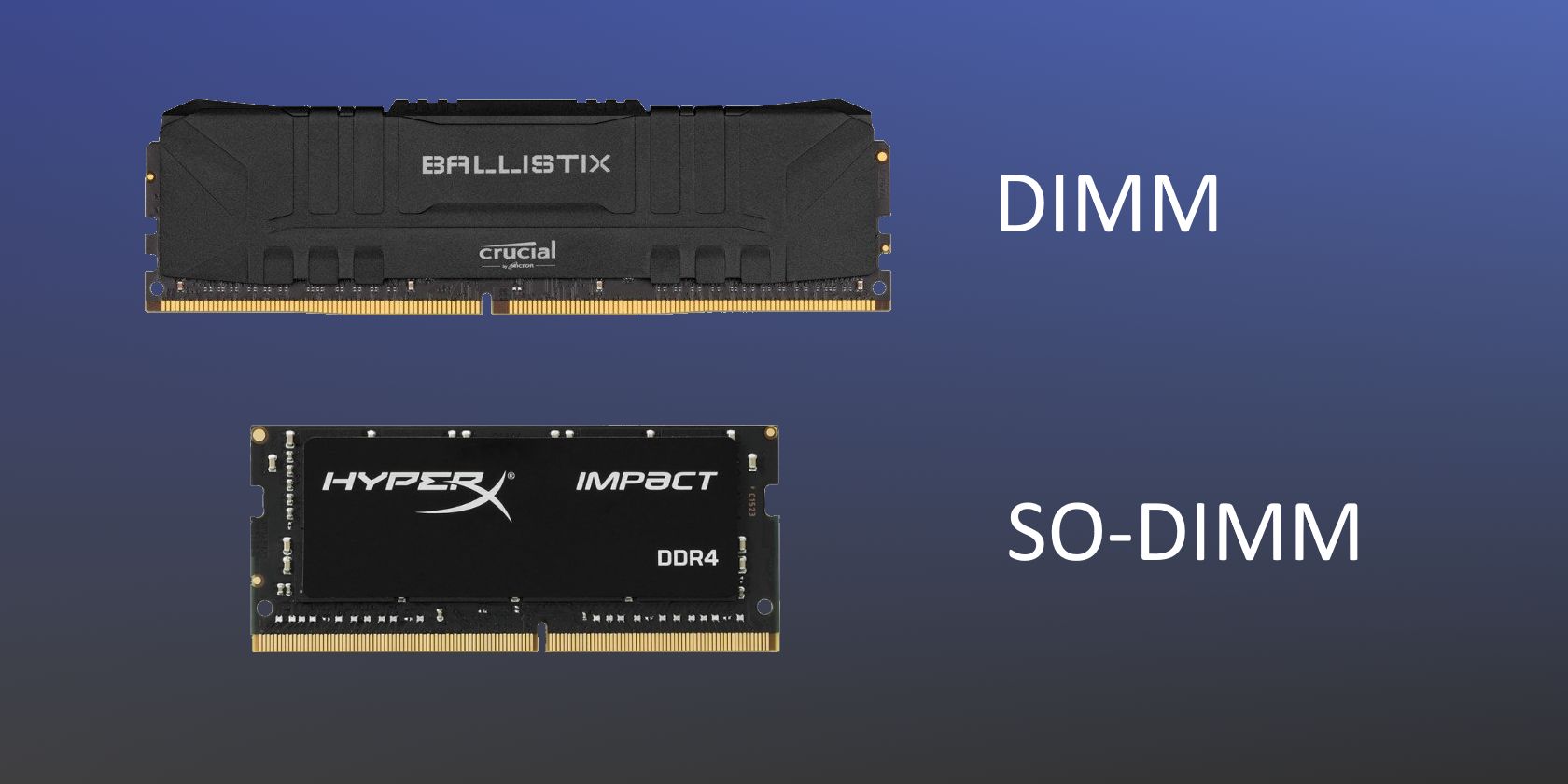
Though the ii RAM form factors utilize the aforementioned technology and functionally piece of work in exactly the same way, you cannot mix them. Yous tin't just jam a DIMM stick into a SO-DIMM slot, and vice versa (the pins and slots don't line up!).
When you are ownership RAM, the get-go thing to figure out is its class factor. Nothing else matters if the stick won't fit!
What Does DDR Mean?
The RAM yous employ in your estimator operates using Double Data Rate (DDR). DDR RAM means that two transfers happen per clock cycle. Newer types of RAM are updated versions of the same engineering, hence why RAM modules acquit the label of DDR, DDR2, DDR3, and and so on.
While all desktop RAM generations are the same physical size and shape, they aren't uniform.
You cannot apply DDR3 RAM in a motherboard that simply supports DDR2. Likewise, DDR3 doesn't fit in a DDR4 slot. To cease whatsoever confusion, each RAM generation has a notch cut in the pins at different locations. That ways you cannot accidentally mix your RAM modules up or impairment your motherboard, fifty-fifty if y'all buy the wrong type.
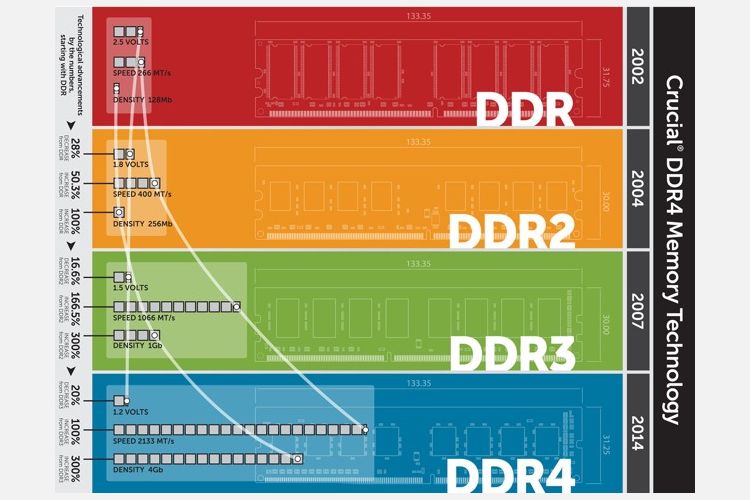
DDR2
DDR2 is the oldest kind of RAM you're probable to come across today. It has 240 pins (200 for And so-DIMM). DDR2 has been well and truly superseded, simply you can still buy information technology in limited quantities to upgrade older machines. Otherwise, DDR2 is obsolete.
DDR3
DDR3 was released way dorsum in 2007. Although DDR4 officially superseded information technology in 2014, you will yet discover many systems using the older RAM standard. Why? Considering it wasn't until 2016 (two years afterwards DDR4 launched) that DDR4 capable systems really picked upwardly steam.
Furthermore, DDR3 RAM covers a huge range of CPU generations, stretching from Intel's LGA1366 socket through to LGA1151, as well every bit AMD's AM3/AM3+ and FM1/two/2+. For Intel, that covers the Intel Core i7 line introduction in 2008 through to the 7th generation Kaby Lake CPUs in 2016.
DDR3 RAM has the same number of pins as DDR2. However, information technology runs a lower voltage and has college timings (more on RAM timings in a moment), and then it isn't uniform. Besides, DDR3 And then-DIMMs accept 204 pins versus DDR2's 200 pins.
DDR4
DDR4 hit the market in 2014 and took some fourth dimension to go the most popular blazon of RAM, taking the summit-spot from DDR3 sometime in 2017. Since then, DDR4 utilize has steadily grown to the point where it now accounts for around 80 pct of all RAM sales worldwide.
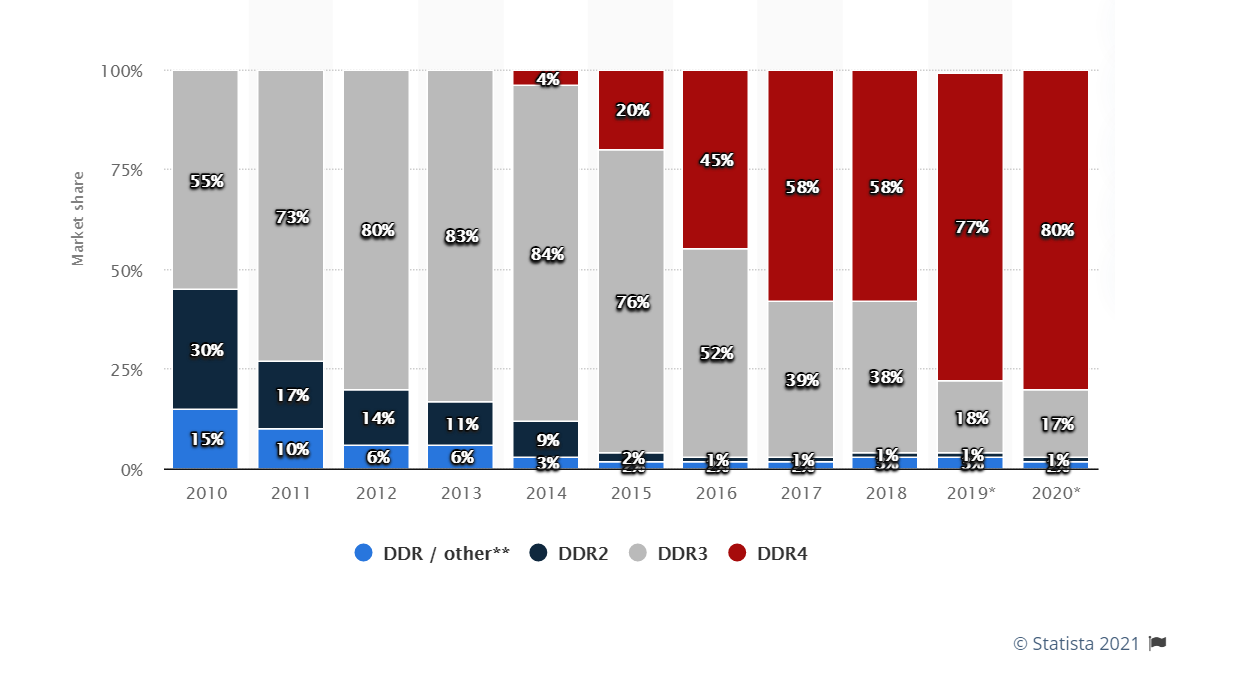
An initial period of loftier prices saw many users stick with the previous generation. However, as the latest Intel and AMD CPUs use DDR4 RAM exclusively, almost users take switched to the new generation or will upgrade the next time they update their organization hardware.
DDR4 drops the RAM voltage even further, from 1.5V to 1.2V, while increasing the number of pins to 288.
DDR5
DDR5 was set to hit consumer markets in 2019. That didn't happen. Information technology didn't really happen in 2020, either, equally the new memory spec was only released in mid-2020. The issue is that at the time of writing, DDR5 RAM is just starting to filter out into the globe, merely but past manner of expensive showcase modules rather than consumer-grade products.
DDR5 will go along with a 288-pin blueprint, although the RAM voltage will drop to 1.1V. DDR5 RAM operation is expected to double the fastest standard of the previous DDR4 generation. For example, SK Hynix revealed the technical details of a DDR5-6400 RAM module, the fastest possible allowed under the DDR5 standard.
Just, equally with any new computer hardware, wait an extremely high price at launch. Also, if you're considering buying a new motherboard, don't focus on DDR5. It isn't bachelor all the same, and despite what SK Hynix says, it will take Intel and AMD a while to prepare
RAM Jargon: Speed, Latency, Timing, and More
You've wrapped your head around SDRAM, DIMMs, and DDR generations. Simply what about the other long strings of numbers in the RAM model? What practice they mean? What is RAM measured in? And what most ECC and Swap?
Here are the other RAM specification terms you need to know.
Clock Speed, Transfers, Bandwidth
You may accept seen RAM referred to by ii sets of numbers, like DDR3-1600 and PC3-12800. These both reference and allude to thegeneration of the RAM and itstransfer speed. The number later on DDR/PC and before the hyphen refers to the generation: DDR2 is PC2, DDR3 is PC3, DDR4 is PC4.
The number paired later on DDR refers to the number of megatransfers per 2nd (MT/s). For example, DDR3-1600 RAM operates at 1,600MT/southward. The DDR5-6400 RAM mentioned above will operate at 6,400MT/south—much faster! The number paired afterward PC refers to the theoretical bandwidth in megabytes per second. For example, PC3-12800 operates at 12,800MB/s.
It is possible to overclock RAM, simply like you can overclock a CPU or graphics card. Overclocking increases the RAM'due south bandwidth. Manufacturers sometimes sell pre-overclocked RAM, but you tin overclock information technology yourself. Just make sure your motherboard supports the higher RAM clock speed!
You might be wondering if you can mix RAM modules of different clock speeds. The reply is that yes, you can, just they'll all run at the clock speed of the slowest module. If yous want to utilise faster RAM, don't mix information technology with your older, slower modules.
You can, in theory, mix RAM brands, just it isn't advisable. You run a greater chance of encountering a blue screen of death or other random crashes when you mix RAM brands or dissimilar RAM clock speeds.
Timing and Latency
Y'all volition sometimes see RAM modules with a series of numbers, similar 9-10-9-27. These numbers are referred to every bit timings. A RAM timing is a measurement of the operation of the RAM module in nanoseconds. The lower the numbers, the quicker the RAM reacts to requests.
The first number (9, in the case) is the CAS latency. The CAS latency refers to the number of clock cycles it takes for information requested by the retentiveness controller to become available to a data pin.
You might observe that DDR3 RAM by and large has higher timing numbers than DDR2, and DDR4 generally has higher timing numbers than DDR3. Even so, DDR4 is faster than DDR3, which is faster than DDR2. Weird, correct?
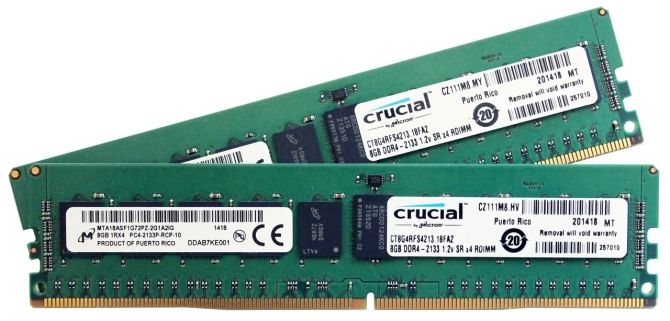
We tin can explain this using DDR3 and DDR4 as examples.
The lowest speed DDR3 RAM runs is 533MHz, which means a clock wheel of one/533000000, or 1.87 ns. With a CAS latency of vii cycles, the total latency is i.87 x seven = 13.09 ns. ("ns" stands for nanoseconds.)
Whereas the lowest speed DDR4 RAM runs at is 800MHz, which means a clock cycle of i/800000000, or i.25 ns. Even if information technology has a higher CAS of ix cycles, the total latency is 1.25 x 9 = 11.25 ns. That's why it'southward faster!
For nigh people, chapters trumps clock speed and latency every time. You will get much more than benefit from 16GB of DDR4-1600 RAM than you get from 8GB of DDR4-2400 RAM. In nigh cases, timing and latency are the last points of consideration.
ECC
Mistake Correcting Code (ECC) RAM is a special kind of retentiveness module that aims to detect and right data abuse. ECC ram is used in servers where errors in mission-critical data could exist disastrous. For example, personal or financial information is stored in RAM while manipulating a linked database.
Consumer motherboards and processors don't usually back up ECC-compatible RAM. Unless y'all are building a server that specifically requires ECC RAM, you should stay away from it.
What Is PC4 RAM?
As to a higher place, PC4 is another way of detailing the data transfer rate of your RAM. But where DDR4-xxxx details the per-bit data rate, PC4-xxxxx details your RAM'due south overall data rate in MB/due south. You can observe out the total data rate of a RAM module by multiplying its frequency by 8.
Thus, DDR4-3000 refers to a RAM module with a 3000MHz frequency. 3000*viii gives us a full data transfer rate of 24000MB/s.
By extension, PC4 deals with DDR RAM. PC3 deals with DDR3 RAM, and so on. So if someone asks if DDR4 RAM is better than PC4 RAM, know they're talking about the same thing, just using a different measurement method.
How Much RAM Exercise You Demand?
Long past are the days where "640K ought to be plenty for anybody." In a earth where smartphones regularly send with 4GB RAM or more, and browsers like Google Chrome play fast and loose with their retentivity allocations, RAM frugality is a thing of the past. The boilerplate amount of installed RAM is increasing beyond all hardware types, likewise.
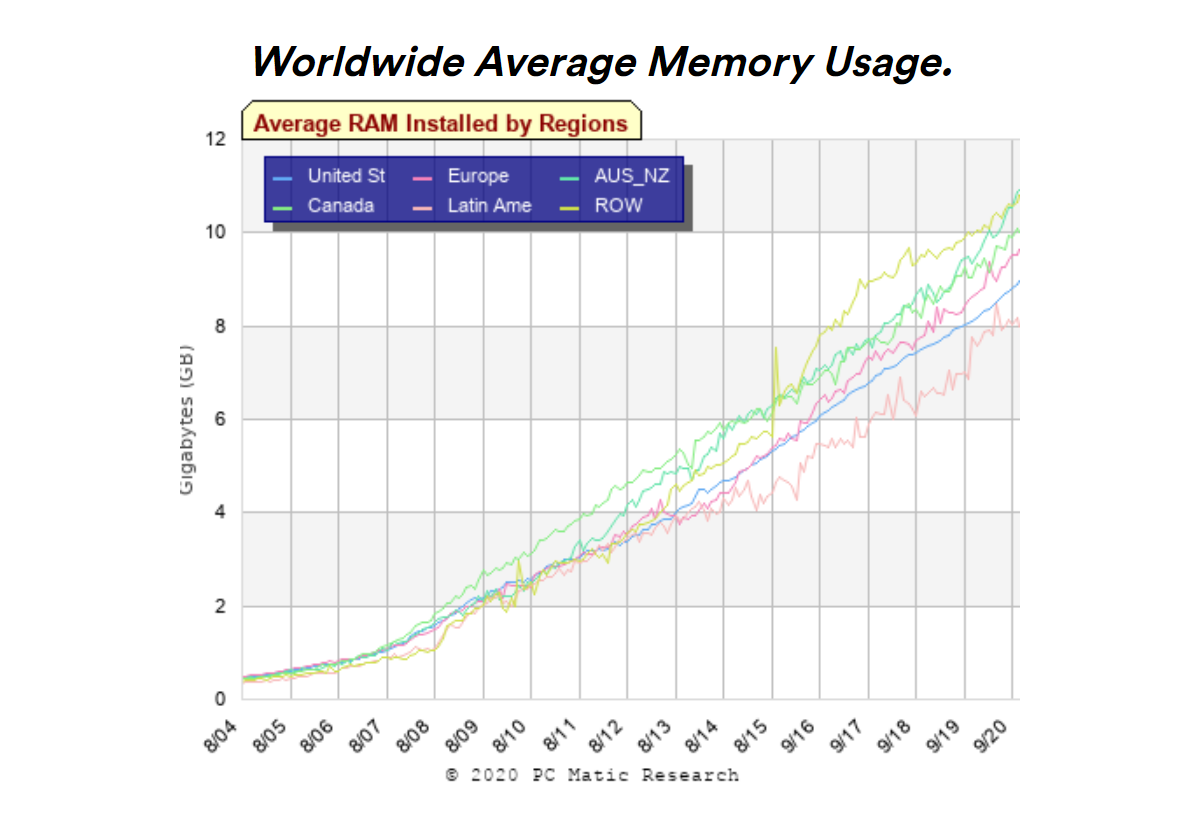
For most people, 4GB is the bare minimum amount of RAM you lot demand for a general usage computer. Operating systems have different specifications, too. For example, you tin can run Windows 10 on simply 1GB RAM, but you volition find your user experience sluggish. Conversely, numerous Linux distributions work extremely well with smaller amounts of RAM.
If you find yourself with six Word documents open up at any in one case, can't bring yourself to close those 60 tabs in Google Chrome, you volition probably want at least 8GB RAM. The aforementioned goes if you want to use a virtual machine.
16GB RAM should exceed the needs of most. Simply if y'all keep utilities running in the background, with a mount of browser tabs and everything else, you'll appreciate the actress RAM capacity. Very few people need 32GB RAM, merely every bit they say, more is more.
A RAM upgrade is definitely one of the easiest means to become an instant functioning boost. However, before committing to an upgrade, check out these common myths and misconceptions regarding RAM. They'll assistance you make a meliorate-informed determination about how much RAM you lot demand for your system and whether an upgrade is the best option.
Understanding Everything Almost RAM
You now know the difference between DDR2, DDR3, and DDR4 RAM, and yous're up to speed on RAM specs.
You lot tin can tell a DIMM from a Then-DIMM, and you know how to spot RAM with faster transfer rates and higher bandwidth. At this point, you're essentially a RAM adept, then it shouldn't feel overwhelming next time you attempt to buy more RAM or an entirely new system.
Really, if y'all have the correct form factor and the corresponding RAM generation, you cannot go wrong. Timing and latency exercise play a role, but capacity is king.
Nigh The AuthorSource: https://www.makeuseof.com/tag/quick-dirty-guide-ram-need-know/

0 Response to "Looking at an Sdram Dimm"
Post a Comment